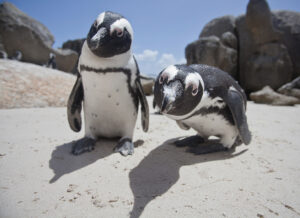For the first time, researchers witnessed wild bonobos making friends with those outside their immediate group. Until now, animal behaviorists believed that only humans do this.
The concept of sharing resources with others and building mutually beneficial relationships with others has always been seen as a human trait. It is one of the reasons we are so successful. But this new study shows that bonobos do the same. The endangered primates form bonds with non-relatives from different groups, although they are selective about who these friends are.
The apes will only form close relationships with a few other individuals. Once the bond is in place, they will travel to see each other, share food and resources, and rest with each other. “They [bonobos] preferentially interact with specific members of other groups who are more likely to return the favor, resulting in strong ties between pro-social individuals,” said lead author Martin Surbeck.
Surbeck and his team created the Kokolopori Bonobo Reserve in the Democratic Republic of Congo. Working with locals from nearby communities — an example of a similar form of human cooperation — they observed two separate groups of bonobos, 31 in all, over two years.
They witnessed 95 friendly interactions between apes from different groups. These ranged from grooming each other to sharing food, giving gifts, and working together to chase away snakes. There were also a number of aggressive interactions, but none of these led to serious harm or death, which is unusual.

A group of bonobos. Photo: Shutterstock
Peaceful coexistence is unusual in primates
These peaceful relationships between apes of different groups are remarkable. Most primates, including chimpanzees, are aggressive toward outsiders. On his first hike through the forests of the reserve, Surbeck was amazed to see that bonobos from different groups were actually excited to see each other. They hooted and gathered together for hours or days.
Bonobos are similar to chimpanzees in some ways, but there are some key differences. Among chimpanzees, the leader is male. Bonobos have a matriarch instead. Rather than mixing with other groups, male chimpanzees will actually patrol the boundaries of their territory to deter other males. If there are any interactions, it is often a fight to the death.
This newly discovered skill not only increases our knowledge of the bonobo’s behavior but might also provide insight into how such social traits developed in humans. We have long assumed that early humans were as hostile to outsiders as chimpanzees and other primates are. Only the evolution of our languages, cultures, emotions, and ability to communicate allowed us to move away from this. Or at least, that is what researchers thought.
The study “shows that constant warfare between neighboring groups…does not seem evolutionarily inevitable,” the team wrote.
The two groups of bonobos even showed different “cultures.” Though they live in the same area, they hunt for completely different prey. There was no overlap. The team hopes to study other groups of wild bonobos to see if they behave in the same way.






